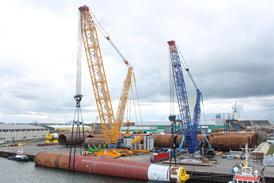April 17 - Mammoet has revealed Dynamic Stability, a new method for calculating the dynamic stability of hydraulic trailers, which provides clients with a detailed assessment of the safety level of their project before it commences.
The assessment deals with more relevant parameters than has been customary in the industry to date and will allow hydraulic transport projects to be executed more safely.
In some cases, Dynamic Stability will also contribute towards more efficient ways of using hydraulic trailers, claims Mammoet.
Dynamic Stability was developed in-house and has been verified and approved by classification society DNV. Mammoet will be using Dynamic Stability for all hydraulic transport projects from now on.
"When you move a load using hydraulic trailers, you have to ensure two things: that the load is stable and does not tip over, and that the trailers carrying the load are strong enough to carry the load," explains Ludo Mous, director operations at Mammoet Europe.
"Up until now Mammoet has always followed the industry standard for ensuring enough strength and stability. This standard is based on two rules of thumb: the 7-degree rule and the 2-degree rule. These rules stipulate that the centre of gravity of the load needs to stay within a seven degree tipping limit and that it can tilt up to two degrees before a hydraulic group is overloaded.
"These rules have always allowed the industry to do their work safely. However, when they were implemented almost forty years ago, they were based on static trailers. Since then, loads have significantly increased in size and weight. At the same time the axle load capacity of trailers has increased, making margins smaller and exact calculations more relevant.
"With this in mind, Mammoet concluded that it is time to reassess industry standards and develop a verified calculation method that incorporates the effects of multiple dynamic forces such as the acceleration and deceleration of the trailer, the forces exerted by the wind, the slope and camber of the road, and the surface on which the load is transported."
"This means we thoroughly engineer what a trailer can and cannot do in each specific situation," explains senior engineer Jurjen de Vries, who was part of the team that developed Dynamic Stability. "Instead of giving a yes or no answer to the question 'Are we within the allowable limit?' we can provide clients, operators and other stakeholders with detailed information on the strength and stability margins for each individual transport project in a single, easy to understand graph."
Mammoet claims Dynamic Stability can ensure a higher level of safety and provide clients with more detailed safety information for their projects, adding that in some cases, it helps the company to design more efficient transport approaches as well.

















